I’d like to introduce you to a new way of gardening. It’s called square foot gardening. I planted my first square foot garden last year and I’m hooked. Here’s the basic gist:
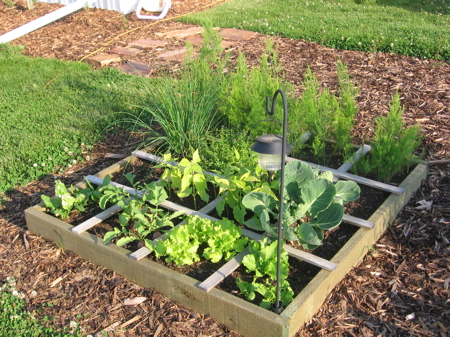 Most gardens are planted in long rows separated by three foot aisles. This means 80% of your garden (that you water, weed, and fertilize) grows nothing. You just walk on it. The square foot method eliminates that 80% of your garden that you don’t use by planting in blocks.
Most gardens are planted in long rows separated by three foot aisles. This means 80% of your garden (that you water, weed, and fertilize) grows nothing. You just walk on it. The square foot method eliminates that 80% of your garden that you don’t use by planting in blocks.
Using the square foot gardening method, you divide a 4′ x 4′ box into sixteen 1 foot square gardens. You then can plant a different crop in each of the squares. For example, you might plant 16 carrots in one box, four beans in another, and one cabbage in another. That leaves you with 13 other boxes to fill! I think it’s a fantastic system, but I’ll let you decide for yourself. Here are some of the reasons why I love square foot gardening.
#1. Perfect Dirt
It doesn’t matter what kind of soil you have, because you won’t be using it. Acidic or alkaline – it doesn’t matter. Rocky or sandy – it makes no difference. You build your own perfect soil. And it’s all really rather simple. It requires just three ingredients.
- Peat Moss
- Compost
- Vermiculite
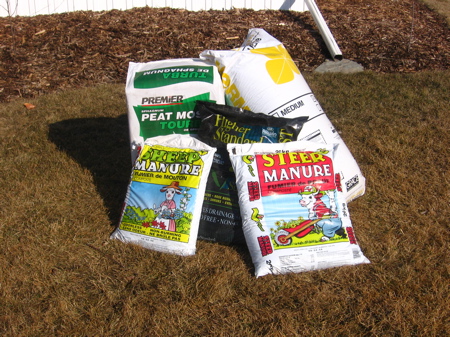 Just mix these three ingredients in equal proportions and you have the finest soil you could imagine. It’s light and loose (thanks to the peat moss), it retains moisture very well (thanks to the vermiculite), and is full of the nutrients your plants need (thanks to the compost). And all these ingredients can be found at you local garden center.
Just mix these three ingredients in equal proportions and you have the finest soil you could imagine. It’s light and loose (thanks to the peat moss), it retains moisture very well (thanks to the vermiculite), and is full of the nutrients your plants need (thanks to the compost). And all these ingredients can be found at you local garden center.
#2. No Weeding
Yup, that’s right. Since you’re making your own soil, there will be no weed seeds in there to start with. Plus, any weed seeds that might happen to blow in are easily removed because the soil is so light and loose. I think I might have pulled out five weeds from my garden last year.
#3. Less Space Required
Your square foot garden takes up only 20% of the space required by a traditional garden. That means you can be more productive with the space you have. It also means you only need to do 20% of the work.
#4. Inexpensive
I just built two square foot gardens this spring and here were my costs:
- Lumber: Free (I used scrap)
- Vermiculite: $20
- Peat Moss: $8
- Compost: $20
Total: $48 for two – $24 each.
Of course with your own lumber and your own compost, you could cut that cost down to $14 each. And once your initial garden is set up, you only need to add a little compost each year. You’ll never again need fertilizer or weed killers.
Convinced yet? Ready to build your own? Here’s how!
Required Materials
- (4) 4′ 2 x 6 boards
- (6) lattice strips (I ripped 1/4 inch thick strips off a 2 x 6)
- (8) 4″ nails or screws
- (12) 1″ nails or screws
- Cardboard, newspaper, or landscape fabric for weed control
- 60 litres of vermiculite (preferably coarse)
- 60 litres of peat moss (about 2 cubic feet compressed)
- 60 litres of compost (at least three different types – I used steer manure, sheep manure, and mushroom compost)
Building the Square Foot Garden
Attach your 2 x 6 boards together with nails or screws to form a four foot square box.
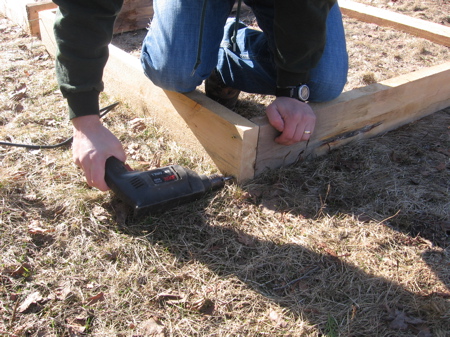
Lay down your newspaper, cardboard, or landscape fabric on the ground where you wish to place your gardens. This will prevent existing grass or weeds from pushing up into your garden. Lay your box on top of the newspaper, cardboard, or landscape fabric.
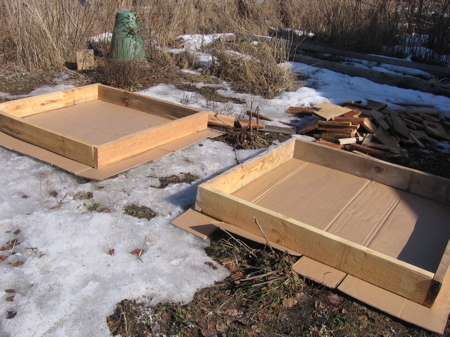
Mix the compost, peat moss, and vermiculite together in equal portions. An easy way to do this is to pile the ingredients on a large tarp and roll them back and forth in the tarp. Then carry the tarp to your garden and pour it in. (Note: You may want to water down the ingredients as they are rather dusty when dry.)
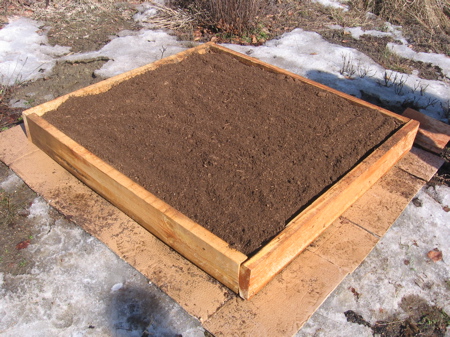
Once the soil has filled the box to the top, place the lattice on top, nailing each piece of lattice in place so that there are sixteen equal squares.
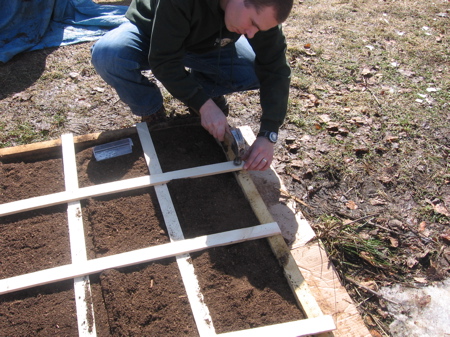
And there you have it. You’re ready to plant!
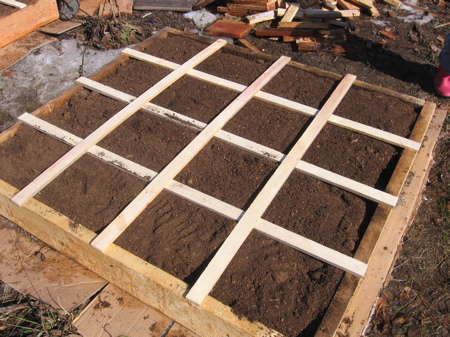
Pretty simple, isn’t it? If you’ve got any questions about how to make your own square foot garden, ask away!
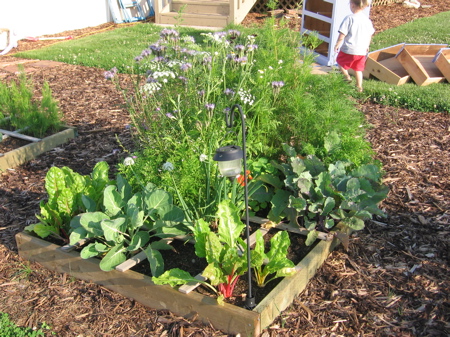
Updated: March 15, 2012
189 replies on “How to Make a Square Foot Garden”
http://www.gardeners.com/
I planted a sq ft garden this year with the mix that was mentioned in the book and the plants look slightly yellowish. What could I be missing or have too much of?
Thanks for your help
Cheryl, there could be a variety of possibilities. If you have poor drainage, it could be too wet. If your compost was a manure that had not yet fully rotted, that could lead to burning your plants. (Burn is also possible if you have fertilized too much.) You could also have issues with insects. Or yet another possibility is that your location doesn’t provide enough sun for the plants you have.
Do any of these sound plausible?
Hi! I am growing tomatoes, red onions & cucumbers, but have them started in regular flower pots. I would love to transplant them to the sfg, but I’m not sure if transplanting is an option? I live in western PA, and any advice would be very much appreciated! Thanks so much in advance!
Transplanting into SFG should be no problem for tomatoes and cucumbers – never tried onions though!
How much watering (frequency) is required for the square foot garden? I live in Edmonton but travel alot. I have a small backyard so the practicality of this solution is awesome but fear that it will require daily watering.
Nicki, As long as the rain can get at your SFGs, you should be just fine. I only water mine when the rain is sparse.
I have done a sfg of sorts the last three years. I just planted stuff in squares with small paths between them in our regular soil. Last year my yield was horrible and the weeds went rampant. I am hunting for a better solution for this year. I was wondering what you thought of mixing peat moss, manure, and possibly sand or something right into the existing soil. Would the added elements eventually wash out of the soil and I would find myself having to re-add it regularly, or would it permanently improve the soil without having to build the boxes, the roots can go as deep as they want, and I can change my planting format to fit what I want to plant for that year? We have a great deal of clay in our soil which makes weeding very difficult unless it is literally soupy out there. If you have any tips I would greatly appreciate it. I am a young mom and want to grow a garden but don’t have lots of extra time that I can forfeit for weeding and such. Thanks!
Sharla,
Let me tell you what I have done in the past – I think it might work for you. For your smaller plants, build the actual SFG. Radishes, carrots, asparagus, chives, lettuce, and the like have all done really well in my SFG. But for things such as peas, beans, potatoes, and corn (Things that you would grow LOTS of to feed a family), I would use your existing garden site, but with a few amendments. Peat moss is great to add to a clayish soil. It really loosens it up and makes weeding SO much easier. Manure (if it is well rotted) is also great to add. I’m not sure about adding sand. I’ve never done it, but it might help with the drainage. I’m not sure how large your plot is or how much you want to spend on amending the soil, but if you can do it, here is what I would recommend: Add two inches of peat moss and one inch of composted material to your soil and then till it in about six inches deep. That should improve things greatly, though you’ll still have to be extra diligent with the weeding for a couple of years to get the weeks under control.
So, no need for a drip irrigation system?
Nope. Drip irrigation would be helpful at times for sure, but certainly not necessary.
Hi Dave,
Just wondering what kind of yield you can get from one sfg (4×4) in a season? Thanks!
Jodie, it really depends on the year and what you grow. But your SFG should yield the same as equal number of plants in regular soil.
Hi, I’m just wondering how companion gardening works with sfg. If I want to plant two vegetables that should avoid each other can I plant them in the same box as long as they’re on opposite ends or should they not even be in the same box? Thanks.
Joni, that’s a tough call. I would guess for things that should be apart, you might need a whole other sfg to put them in.
Perhaps your readers would be interesting in viewing the official Square Foot Gardening Foundation Website and Forum. A nice group of people who love to help others with their Square Foot Gardens.
http://www.squarefootgardening.org/
Sorry I should have proof read my prior post before hitting submit.
Perhaps your readers would be interested in viewing the official Square Foot Gardening Foundation Website and Forum.
http://www.squarefootgardening.org/
I tried a SFG last summer with my kids and it was a HUGE success! (With the exception of those pesky green worms that came and ate all my leafy plants, like broccoli and cauliflower!)
I used 4×6’s and medium weight landscape fabric, since we had stubborn weed issues in that part of the yard. I didn’t use cardboard, and I just purchased garden soil from the Home Depot. What is the benefit to using that particular mixture again? This year, we are making compost, and plan on mixing that into the garden soil. I don’t like the idea of using ingredients that may have unneccesary chemicals in them, so I am trying to do this as naturally as possible.
Also, (don’t laugh, I am a beginner!) do you know if I could plant a long, narrow row of single corn on the cob plants at the back of the yard in a raised bed? Will there be enough depth to create a sturdy root base?
Thanks for the advice. We are south of Red Deer this summer and are excited to see how our garden differs from our Northern Alberta garden last year!
see attached: beginning of last year’s garden!
Heather: The peat moss keeps the soil loose, the vermiculite holds the water, and the compost provides the nutrients. As to the corn, a long single row might not pollinate very well. Corn tends to do better in groups. But, by all means, give it a try! It might work fine!
Hi Dave! Where did you get your vermiculite? We want to build square foot gardens this year… We are in the Edmonton area…
Sherry: I got my vermiculite from Peavy Mart in Red Deer.
Do you have any problems with critters trying to come up from under the bottom?
Cathie: I’ve had no issues with critters!
I am unable to find coarse vermiculite in the south Okanaganarea. They places I’ve called say they are unable to get it. Medium grade is available. Is medium better than no vermiculite? Is there another option?
Jane: Medium vermiculite is just fine. I’ve ended up using that for many of my SFGs. Coarse is better, but medium is just fine!
Thank you for the encouragement to go with medium! I wonder why coarse grade is so rare now?
Jane,
I have been looking for the coarse grade as well and I’ve been told that a mine that was supplying the local stores has run dry and closed. All I can find now is fine vermiculite, which will discintegrate from the gardens in a few years. I’m still searching if anyone knows of a source for under 35 a bag near Edmonton, AB!
I’m wondering if any of you could provide a garden plan (what you’ve planted and in which squares) for what you’ve done. We’re in the Red Deer area as well and we’ve never gardened before, so it would be a useful starting point to have SFG plans that have worked for you! Thanks.
Hello, thanks for all your help. About to build one of these gardens in Switzerland.
I would like to know if you can sfg on top of grass. I live in a house with a backyard full of grass and last year I tried to pull out the grass to create a garden but it was too difficult. Can I sfg right over the grass? I realize it will kill the grass but that doesn’t matter. Are there issues of weeds or grass coming into the sfg?
Rene: Yes, you can. The grass will come through unless you put down some kind of barrier: layers of newspaper, cardboard, heavy landscape fabric, etc…
Hi
I was wondering what to put into my sfg boxes. I want to plant both, flowers and vegetables…we live in Edmonton and have a yard that faces south…any suggestions would be great!
oops… forgot to ask when to plant things here [Edmonton]?
Catherine: Look here – https://www.albertahomegardening.com/square-foot-garden-planting-plans/ And as to when to plant… That changes every year. Lots of people go with the May long-weekend. Some wait until June. It depends on the weather!
This is fun to do. But I have mixed 60l of compost, 60l of fine vermiculite and 3.8 cu ft of peat moss and it provides enough soil for 1 sq ft garden, not 2. Is this what you meant?
Stephen: Yes, that recipe is for one sfg that is 4′ by 4′.
Water issues!
I now have ten SFG installed but they are using huge amounts of water! I have them on heavy landscape fabric right over the existing grass. Are other people having this problem? How often are you having to water?
Hi Everyone,
Loving this site! I’m building my first 3 – 4×4 SFG in a couple days. I’m really excited about it. Right now though my issue is vermiculite. I have only checked out one place but they only sell 30 lt bags for $15 each, I would need 9 of them (one of my gardens is 10 inches instead of 6) which is a bit costly. Anyone know where to find some cheaper stuff in larger quantities in the Calgary area? I see that Red Deer has some, I may need to travel there, but if I can avoid that it would be fabulous! Thanks!
I built 2 4×6′ beds last year and had great results. Although I made one mistake that is causing me problems this year. I had cut out the sod and flipped it over in the bottom of the beds, then filled the beds with soil. I didn’t use any barrier to prevent the grass from growing in. This spring, I am now starting to see grass growing in.
Do you recommend that I rebuild the beds? Or is there some other way to get rid of the grass besides constant pulling?
Giselle: I would probably take out the soil and then lay down some sort of barrier (landscape fabric, newspapers, cardboard, etc…) and then re-fill your boxes. Otherwise you’ll be pulling grass forever!
To Ashley, I found some vermiculite in 110L bags down in High River at Peavey Mart. Came to around $20 per bag. it’s not the coarse stuff, but I’m not complaining compared to the prices in calgary!
Hi, I’ve read the article and all the comments. I’m getting ready to build my garden this weekend. Do I still need 60 Litres of peat moss? You had mentioned that it doubled in size when wet.
Oh and, is this a good type of compost?
http://www.rona.ca/shop/~compost-biomax-seaweed-compost-premier-63990_!compost_shop
Do I still need 3 different kinds? 🙂 Thanks in advance I’m completely new to gardening.
Joanne,
As long as all ingredients are in equal proportions, you’ll be fine. The compost you mentioned is just fine, but ideally you will still want some other varieties. This compost from Rona is seaweed compost – perhaps add some sheep or cow manure, and some mushroom compost as well.
I have a question about the peat moss. I have had so many ants invade my garden when I used peat moss so I am very hessitant to try it again. Any advice on that would be much appreciated.
I have used news paper (very thick) cardboard & land scape cloth. The news paper & cardboard broke down and the worms can come up it also helps to hold water & long root crops have more room. Was dissapointed in the land scape cloth as those beds seemed to need more water no worms even after 5yr. We also have clay soil & learned the hard way not to put sand with clay can create a better concrete. Peat moss vermiculite & compost are the best bet. Have not heard any thing about mulch to keep weeds down believe me it works great. Last summer was a bad year because of all the rain chick weed just took over. Happy gardening
Hi, I just created a blog and posted a link to this article specifically. I hope that’s not a problem.. if it is let me know and I can take it down. 🙂
Thanks a lot for the quantitie, It was good to have it in litres.
And thank you Brian, I went to Peavy Mart and it was way cheaper than every where else in Calgary. I paid $85 for vermiculite/peat moss/compost for 4 square foot gardens. Don’t forget to take a big car if you decide to go there with friends. We had to play tetris to put it inside and on the roof (we bought enough for 10 gardens).
thanks again.
Hi There!
This is so incredible and the posts are very helpful. I just have a few questions…
Half of my backyard has cement pads and bricks laid and the other half just isn’t space I am willing to go without (in having the SFG use that space). I am wondering if the SFG can be built on top of the brick pads? I am clear that drainage is important but am curious as to what the best option is for the base.
Also, given we have brick pads, ants are always a challenge. Should I be worried?
Finally, is it too late in the season to do this?
Thanks so much!
Danielle
Danielle: I think SFGs would be just fine on brick pads – and it’s not too late! As to the ants, I would say try and see what happens. If ants become a problem, deal with it then!
Hi again,
I just noticed an earlier post that mentioned how much the peat moss expanded. Are the quantities that are listed in the “how to” section the quantities dry or after the ingredients have been watered down?
Thanks!
Danielle: It’s not so much whether its wet or dry – it’s just that peat moss comes in compressed blocks. Thus the measurements are based on the uncompressed peat moss. But it’s not a spongecake recipe – it’s just dirt! So don’t worry about being too exact. 🙂
Dave!
Thanks so much! I went out yesterday and managed to find everything I needed (in right quantities!) at Apache Seeds here in Edmonton!
Thanks for all of your guidance and we can’t wait to get started!
Happy Summer!
can I use brown paper bags to stop the grass from coming through- instead of cardboard?
Thanks!
Sarah: You could use brown paper bags, but my guess is that you would need several layers of them. Cardboard is much thicker and would take longer to break down. My concern would be that the grass could just push right through a single layer of brown paper bags. As an alternative, you could use several layers of newspaper.
Hi Dave,
I am going to do the majority of my planting from seed but there are a few items that I intend to transplant (i.e. tomatoes, basil, rosemary, maybe some marigolds). My concern is this, with transplanting plants that come from nurseries are you at risk of “contaminating” the SFG soil blend with the soil that doesn’t shake off the roots of the transplants?
What are your thoughts on this?
Thanks again!
Danielle
Danielle: Not a problem! First of all, the dirt that nurseries use for their plants is actually very similar to the SFG dirt. And secondly, the small amount of soil that comes with your plants is comparatively insignificant.
Awesome, thanks so much!
Thank you Dave.
We planted our first 4×4 box this year with plans to expand at a rate of about 1 or 2 a year. We have a cottage in central BC about 1000 ft. above the nearest zone 3 and the “soil” is mostly gravel so we have our challenges. Last year, the tomatoes froze inside the greenhouse in July! We only get out about once a week but so far there’s been enough rain and our little garden is doing well.
Your guide is awesome (I have the book but your guide is succinct and covers all the basics) and I love the patience with which you answer questions. The input from other gardeners is wonderful help. Thanks so much.
I think square foot gardening can change the world for the better!
We have deer problems (of course) so we adapted on online tip and have placed a bamboo stick on each corner of our little garden with fishing line wrapped around at about 2ft and 4 ft. Apparently deer touch the line with their legs which creeps them out (since they can’t see it) and they hightail out of there. That’s the theory, anyway, and it will be interesting to see if it works.
In planning stages of building a raised garden box, approx. 28″ high – height of 2-2×10’s. Will then use the square foot concept. Purpose of the height is for ease of working around ie. seeding, weeding, harvesting etc. I plan to only have 12 to 18″ of soil. What would you recommend to fill the rest. Should I fill with rocks etc. or put in a false bottom of plywood. Any suggestions?
Rob: With 12″ to 18″ of soil, that would be a lot of weight for plywood. (6″ to 8″ should really be all you need anyway.) You could fill it with rocks, although if it were me, I think I’d fill it with something compostable. Maybe straw or grass clippings… Then you get the benefit of the heat from the composting action, plus a whole pile of great compost to use next year!
Sorry, should of course said height of 3 – 2×10’s !
We planted our first box this year, planning to expand year by year. The cost of the mix was rather high (about $ 50 for one box) but we thought okay, it will last for years. Well, maybe it’s this weird summer we are having but very few seeds have germinated, nothing is anywhere near usable size, even the tiny lettuce plants (not from seed) are still tiny. We are at high in the BC mountains so zone 3 is optimistic (we usually have at least a bit of frost every month) but the all around us the wild things are growing and blooming even better than most years.
So, what’s going on? Any thoughts appreciated. My husband (he’s the gardener) says, “the soil’s no good”. I see his point. A few feet away, in good garden soil, the peas are doing great, for example. He is going to be very hard to convince to carry on the experiment if I can’t come up with a reason why our first box is a bust.
njoy: That seems very odd to me. Could you put up a picture for us? Perhaps we’d get some clues. Also, could you tell us exactly what you used for the soil mix?
Thanks, Dave: I’ll get a photo asap (might be a few days). The mix was medium vermiculite, a mixture of several composts and peat moss from a variety of sources. Seemed like good stuff.
Here it is. Many different seeds planted but very little growth. The lettuce plants are much smaller than could be reasonably expected. Ordinarily, I’d expect it was lack of water but not this summer.
[img]https://www.albertahomegardening.com/wp-content/uploads/2011/07/sqftgarden.jpg[/img]
njoy: Sorry for the delay in replying. Judging from the picture, your plants look a little bit yellow. If I were to give an educated guess, I would guess you have a nutrient deficiency – perhaps nitrogen? If that’s the case, some manure or other fertilizer containing nitrogen should fix things up.
Okay, no answers so I went looking elsewhere and found that some people do experience the same problems that I (and Terri # 54, above). One opinion is that there is “too much” compost in the mix but since most folks have good yields that doesn’t make sense. I used 3 different kinds of compost in my box so it occurs to me that perhaps I got a bag of “hot” compost. Anyway, it seems logical that something is wrong with one of the ingredients. I still have almost no growth and yet all around me, in good soil and bad, things are growing.
Where can I buy vermiculite in large bag quaantities?
The large grade (not small domestic)
Please advise. Thanks.
I am new to gardening and not sure what would be the right time to grow vegetables. Also, do you have any SFG plan to share for beginners.
I am in edmonton and my family like to eat tomatoes, squash, eggplant, string beans, cabbage, cauliflower, salad greens and some herbs
Was introduced to this concept today at Seedy Saturday. Would you plant one tomato plant per 1×1 section? What about beans? I am certainly following your feed for info.
Cheers!
Darlene: Yes, I would plant one tomato plant per 1×1 square. For beans, depending on variety, I would maybe plant four.